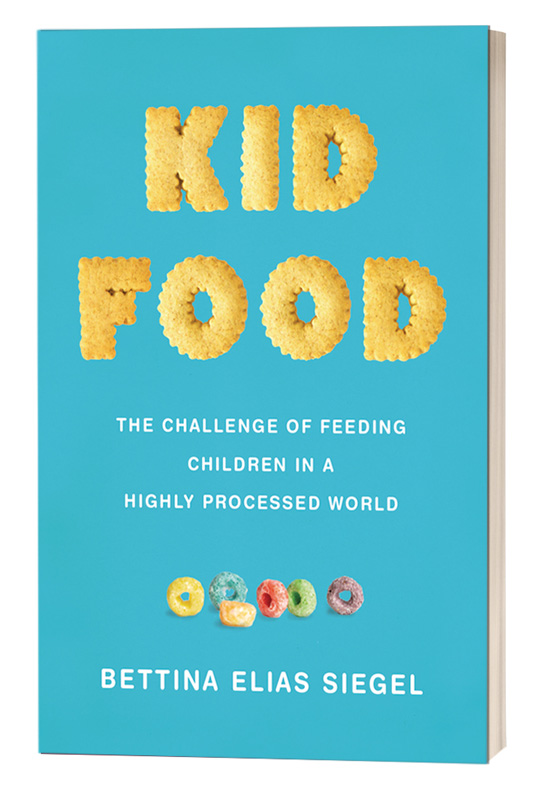What does $2 billion dollars pay for? The entire city budget of Oakland, CA. Ownership of the Philadelphia 76ers. Or, how about the loyalty and “pester power” of millions of American children? Around $2 billion dollars is what food and beverage companies spend every year marketing their products to kids. And, as any parent who has ever done battle with their child over a cartoon character cereal will attest, that’s a good investment. For the companies’ bottom lines, that is. Not for children’s health or parents’ sanity.
 It’s these systemic issues impacting what, why and how our kids eat—and what parents can do about them—that writer, former lawyer and mom of two, Bettina Elias Siegel, set out to uncover. In 2019, she published her first book “Kid Food: The Challenge of Feeding Children in a Highly Processed World,” which the New York Times called “a blueprint for how to raise healthy eaters in a fast-food culture.”
It’s these systemic issues impacting what, why and how our kids eat—and what parents can do about them—that writer, former lawyer and mom of two, Bettina Elias Siegel, set out to uncover. In 2019, she published her first book “Kid Food: The Challenge of Feeding Children in a Highly Processed World,” which the New York Times called “a blueprint for how to raise healthy eaters in a fast-food culture.”
The book is the natural outcome of a decade or so of learning, writing and advocacy. Seigel wrote a popular blog called The Lunch Tray from 2010-2020—now a Substack newsletter—and her writing about children and food has also appeared in outlets like the New York Times, Civil Eats and the Houston Chronicle.
In this interview with Siegel, we explore kid food issues from highchairs, to health claims, to the halls of power.
Claire Raffel: First, let’s talk about the youngest eaters. One of your chapters explores how children’s palates are shaped in their first years of life. What did you learn, and how can caregivers, educators and policymakers maximize this developmental stage to encourage kids to accept healthier foods?
Bettina Siegel: In researching “Kid Food,” I was fascinated by the emerging research on early palate development. Apparently, how we introduce solids to babies—and which foods we offer first—can actually shape their long-term food preferences for the better. So, based on this research, parents and other caregivers may want to postpone the introduction of sweet fruit until babies have been exposed to a wide variety of vegetables, allowing babies to first become accustomed to bitter and sour flavor notes.
Raffel: You delve into the food industry’s “divide and conquer” strategy—i.e., marketing to both kids and parents—to break down the family unit. Can you explain this for us?
Siegel: When I talk about the “divide-and-conquer strategy,” I’m referring to all the ways in which the processed food and beverage industries try to break down the family unit to get their products into our homes.
On the child side of the equation, these two industries collectively spend almost $2 billion each year on marketing directed specifically at kids, reaching through every possible medium, from television ads, to smart phone games, to school classrooms. Not surprisingly, it’s money well spent. Research shows this bombardment of marketing really does shape kids’ food preferences and eating behavior…for the worse, unfortunately, since the vast majority of these marketed products are unhealthy. This is why child-directed food and beverage marketing has actually been cited as a significant driver of the childhood obesity crisis.
And even as adults are worn down by children’s demands in the grocery store, they’re also being intentionally confused about these products’ nutritional value. Claims like “made with real fruit” or “whole grain” may be literally true, but they typically lend an underserved “health halo” to highly processed, nutritionally poor products. When you put it all together, it’s an incredibly effective strategy to keep us buying products that don’t actually support our family’s health.
Raffel: In one of your chapters, you go through a young child’s day and document all the occasions she’s offered “just one treat” by adults. What did you learn from that exercise? Why should people care about all these treats?
Siegel: One of the most cited chapters in “Kid Food” is called Just One Treat, in which I take the reader through a fourth-grader’s typical day to highlight all the instances in which adults might offer her sugary foods and drinks. She might, for example, be offered a candy reward by her teacher, be given gumdrops or marshmallows to use in her math lesson, get a packet of Oreos at sports practice, and score a free lollipop when she accompanies her dad to the dry cleaners.
In each instance, the amount of sugar is usually pretty negligible, and few parents would object to their child having “just one” of anything. But by adding it all up, I demonstrated that this fourth grader could easily have consumed 18 to 25 teaspoons of sugar in a single day just from adult-provided treats and not including any of the sugar she might consume in her meals or from treats or desserts offered by her own parents. It’s a pretty shocking figure, and hopefully provides a good reminder to all caregivers that even though your “one” treat is no big deal, it really needs to be viewed against the context of a child’s entire daily diet.
How has the Covid-19 pandemic shaped your thinking about kids and food?
One thing that the pandemic has shown us very clearly is the absolutely critical role of federal nutrition programs in feeding millions of American children, including through school meals, P-EBT (Pandemic Electronic Benefit Transfer, which provides families the financial equivalent of school meals missed due to Covid closures) and SNAP (the food stamp program). But we need to be doing much more to support and boost those programs, especially now, when hunger in America is at an all-time high.

And we’ve also seen a troubling correlation between Covid deaths and those affected by obesity and diet-related diseases, which only further points up the importance of eliminating health inequities in this country and ensuring that in the future, all families have access to fresher, healthier food.
Raffel: Let’s talk about the future. Your book concludes with four broad areas where we might improve our children’s diets at a societal level. As we look ahead to a new administration in Washington, can you briefly describe these policy goals?
Siegel: There are so many ways in which our food system is broken, but in “Kid Food” I specifically focus on a few policy goals that could especially benefit children. So I discuss the ways in which we might ban, or at least curb, unhealthy food marketing to children, as well as making it a lot harder for food companies to mislead parents with meaningless nutrition claims.
I also offer a variety of proposals that would continue the progress we’ve seen in America’s school meal programs. And finally, I talk about various proven ways to get kids invested in their own healthy eating; unfortunately, in today’s toxic food environment, simply going with the flow is a recipe for poor health.
Hungry for more? Siegel just launched The Lunch Tray Substack newsletter, which covers all things kids and food—from school food policy to family dinner recipes to picky eating help, which you can subscribe to here.

Claire Raffel
Claire Raffel’s work focuses on building equitable and sustainable food systems. She currently works with Matriark Foods, a food company upcycling farm surplus and fresh-cut remnants into healthy, affordable, low sodium vegetable products for schools, health care, shelters, and other foodservice. Until recently, she was the deputy director for the Laurie M. Tisch Center for Food, Education & Policy, Teachers College Columbia University, where she led policy/advocacy work, community partnerships and external relations.



